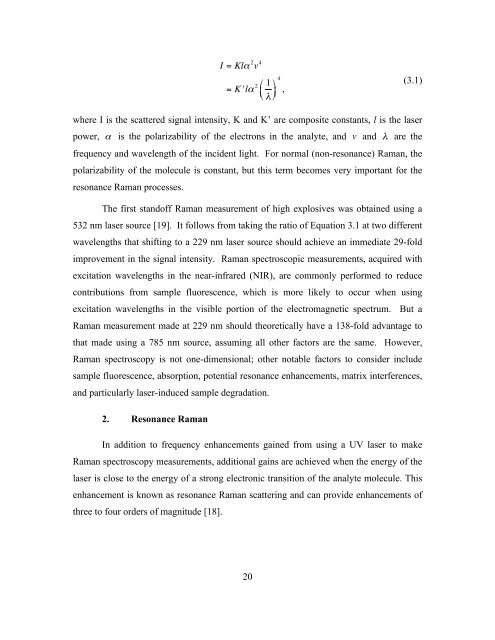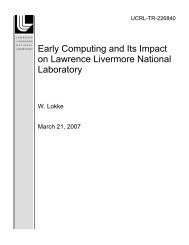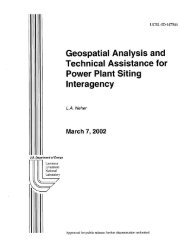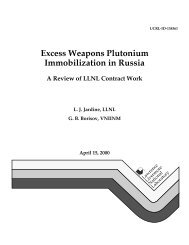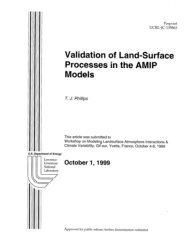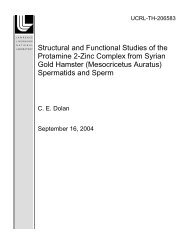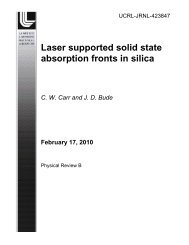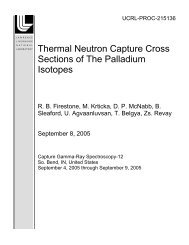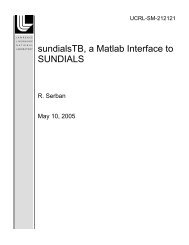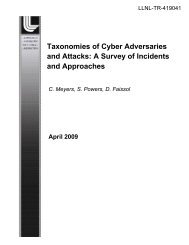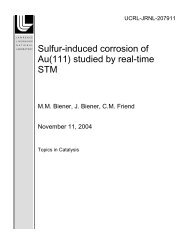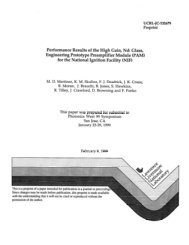Ultraviolet Resonant Raman Enhancements in the Detection of ...
Ultraviolet Resonant Raman Enhancements in the Detection of ...
Ultraviolet Resonant Raman Enhancements in the Detection of ...
You also want an ePaper? Increase the reach of your titles
YUMPU automatically turns print PDFs into web optimized ePapers that Google loves.
I = Klα 2 v 4<br />
= K 'lα 2 ⎛ 1 ⎞<br />
⎝<br />
⎜<br />
λ ⎠<br />
⎟<br />
20<br />
4<br />
,<br />
(3.1)<br />
where I is <strong>the</strong> scattered signal <strong>in</strong>tensity, K and K’ are composite constants, l is <strong>the</strong> laser<br />
power, is <strong>the</strong> polarizability <strong>of</strong> <strong>the</strong> electrons <strong>in</strong> <strong>the</strong> analyte, and and are <strong>the</strong><br />
frequency and wavelength <strong>of</strong> <strong>the</strong> <strong>in</strong>cident light. For normal (non-resonance) <strong>Raman</strong>, <strong>the</strong><br />
polarizability <strong>of</strong> <strong>the</strong> molecule is constant, but this term becomes very important for <strong>the</strong><br />
resonance <strong>Raman</strong> processes.<br />
The first stand<strong>of</strong>f <strong>Raman</strong> measurement <strong>of</strong> high explosives was obta<strong>in</strong>ed us<strong>in</strong>g a<br />
532 nm laser source [19]. It follows from tak<strong>in</strong>g <strong>the</strong> ratio <strong>of</strong> Equation 3.1 at two different<br />
wavelengths that shift<strong>in</strong>g to a 229 nm laser source should achieve an immediate 29-fold<br />
improvement <strong>in</strong> <strong>the</strong> signal <strong>in</strong>tensity. <strong>Raman</strong> spectroscopic measurements, acquired with<br />
excitation wavelengths <strong>in</strong> <strong>the</strong> near-<strong>in</strong>frared (NIR), are commonly performed to reduce<br />
contributions from sample fluorescence, which is more likely to occur when us<strong>in</strong>g<br />
excitation wavelengths <strong>in</strong> <strong>the</strong> visible portion <strong>of</strong> <strong>the</strong> electromagnetic spectrum. But a<br />
<strong>Raman</strong> measurement made at 229 nm should <strong>the</strong>oretically have a 138-fold advantage to<br />
that made us<strong>in</strong>g a 785 nm source, assum<strong>in</strong>g all o<strong>the</strong>r factors are <strong>the</strong> same. However,<br />
<strong>Raman</strong> spectroscopy is not one-dimensional; o<strong>the</strong>r notable factors to consider <strong>in</strong>clude<br />
sample fluorescence, absorption, potential resonance enhancements, matrix <strong>in</strong>terferences,<br />
and particularly laser-<strong>in</strong>duced sample degradation.<br />
2. Resonance <strong>Raman</strong><br />
In addition to frequency enhancements ga<strong>in</strong>ed from us<strong>in</strong>g a UV laser to make<br />
<strong>Raman</strong> spectroscopy measurements, additional ga<strong>in</strong>s are achieved when <strong>the</strong> energy <strong>of</strong> <strong>the</strong><br />
laser is close to <strong>the</strong> energy <strong>of</strong> a strong electronic transition <strong>of</strong> <strong>the</strong> analyte molecule. This<br />
enhancement is known as resonance <strong>Raman</strong> scatter<strong>in</strong>g and can provide enhancements <strong>of</strong><br />
three to four orders <strong>of</strong> magnitude [18].


